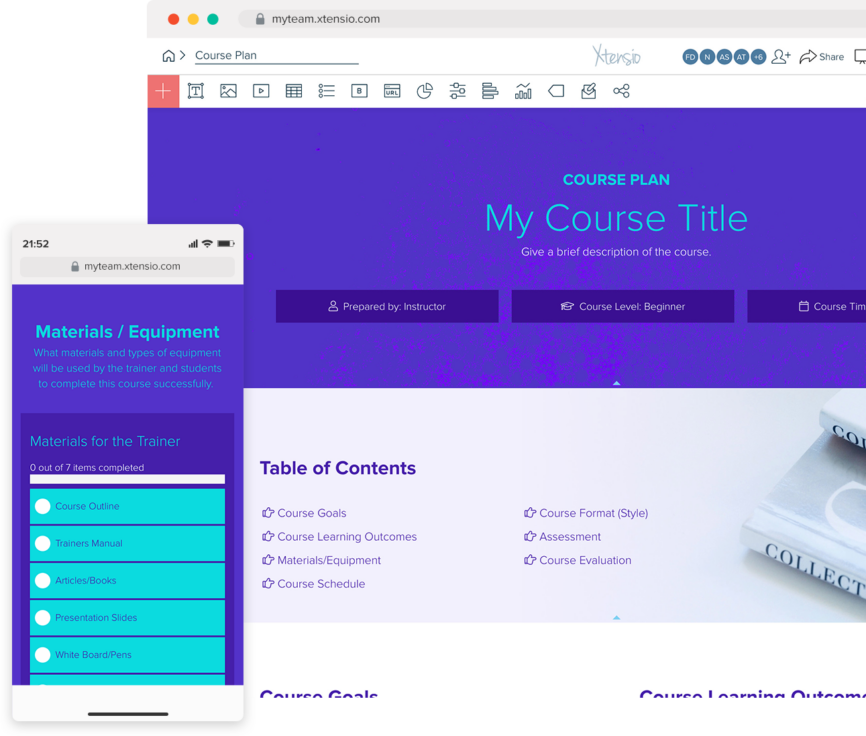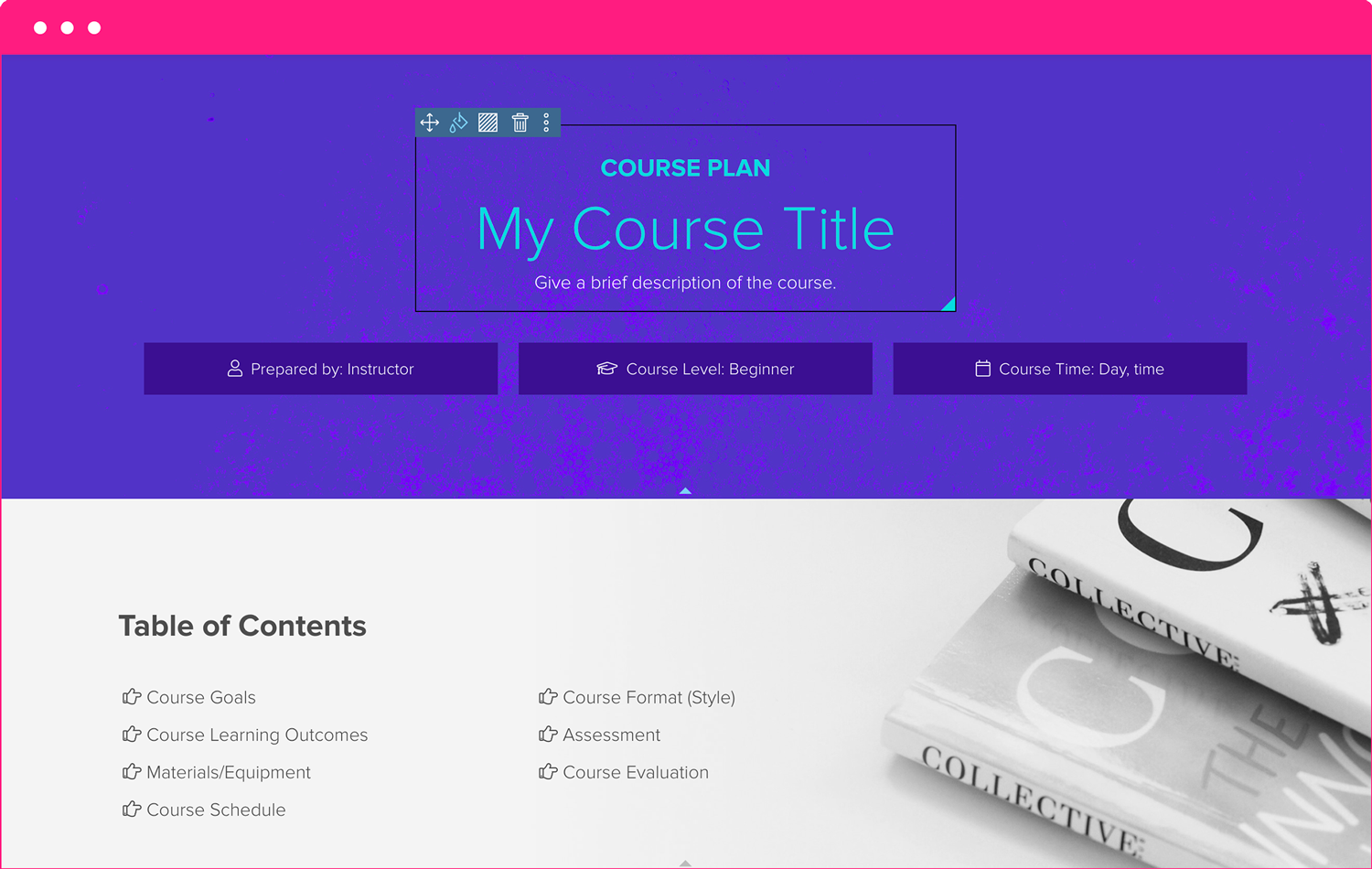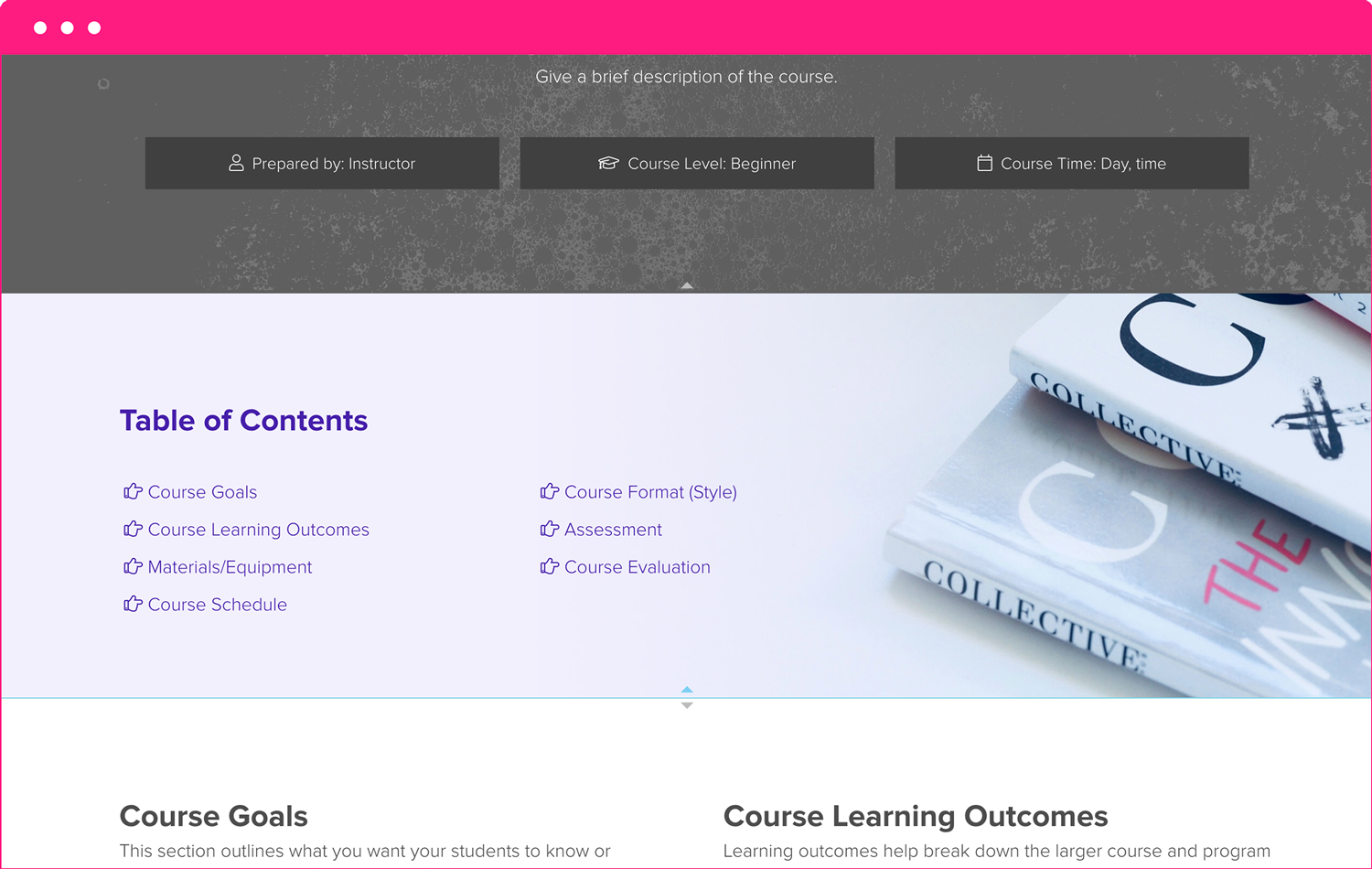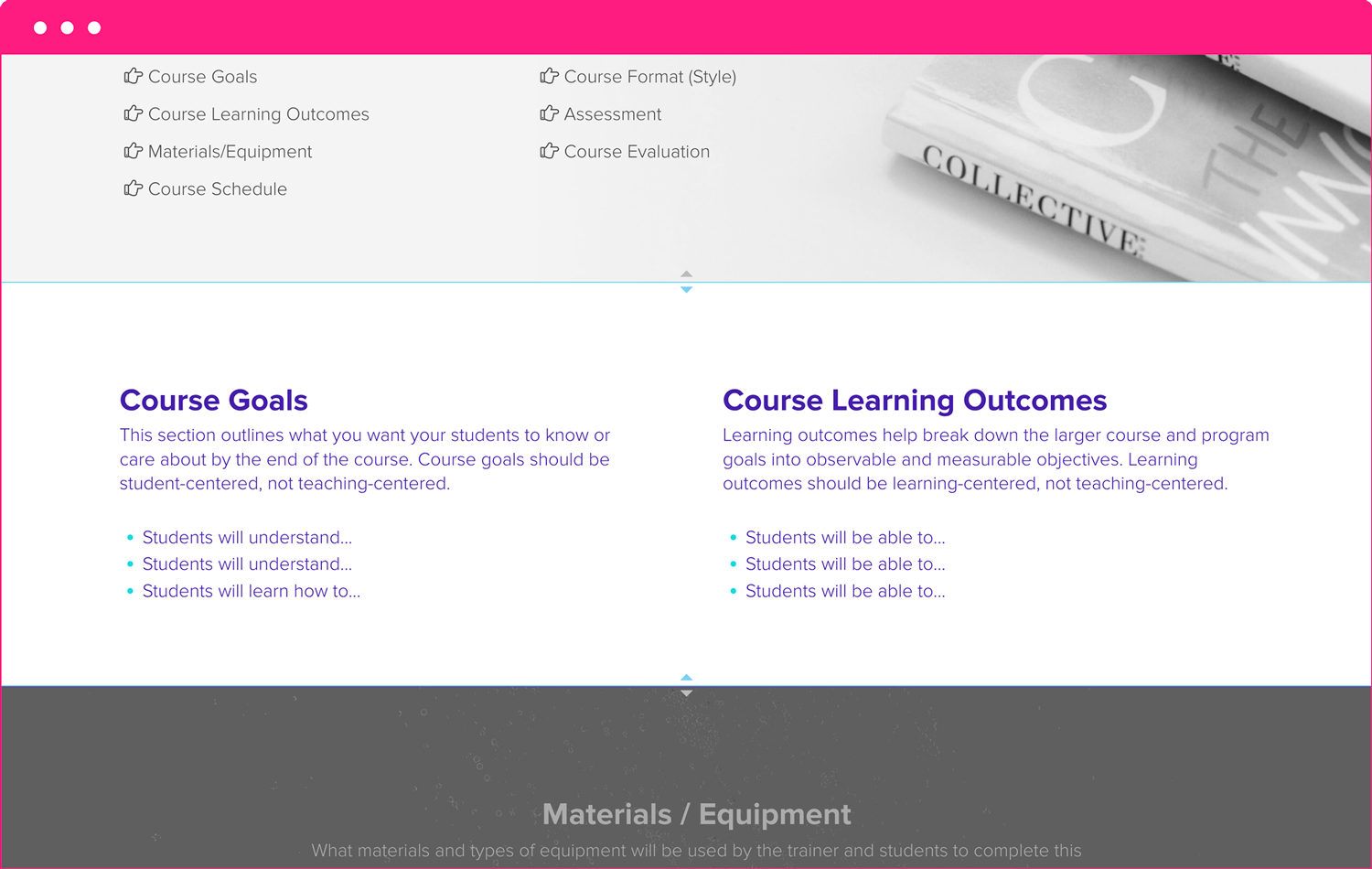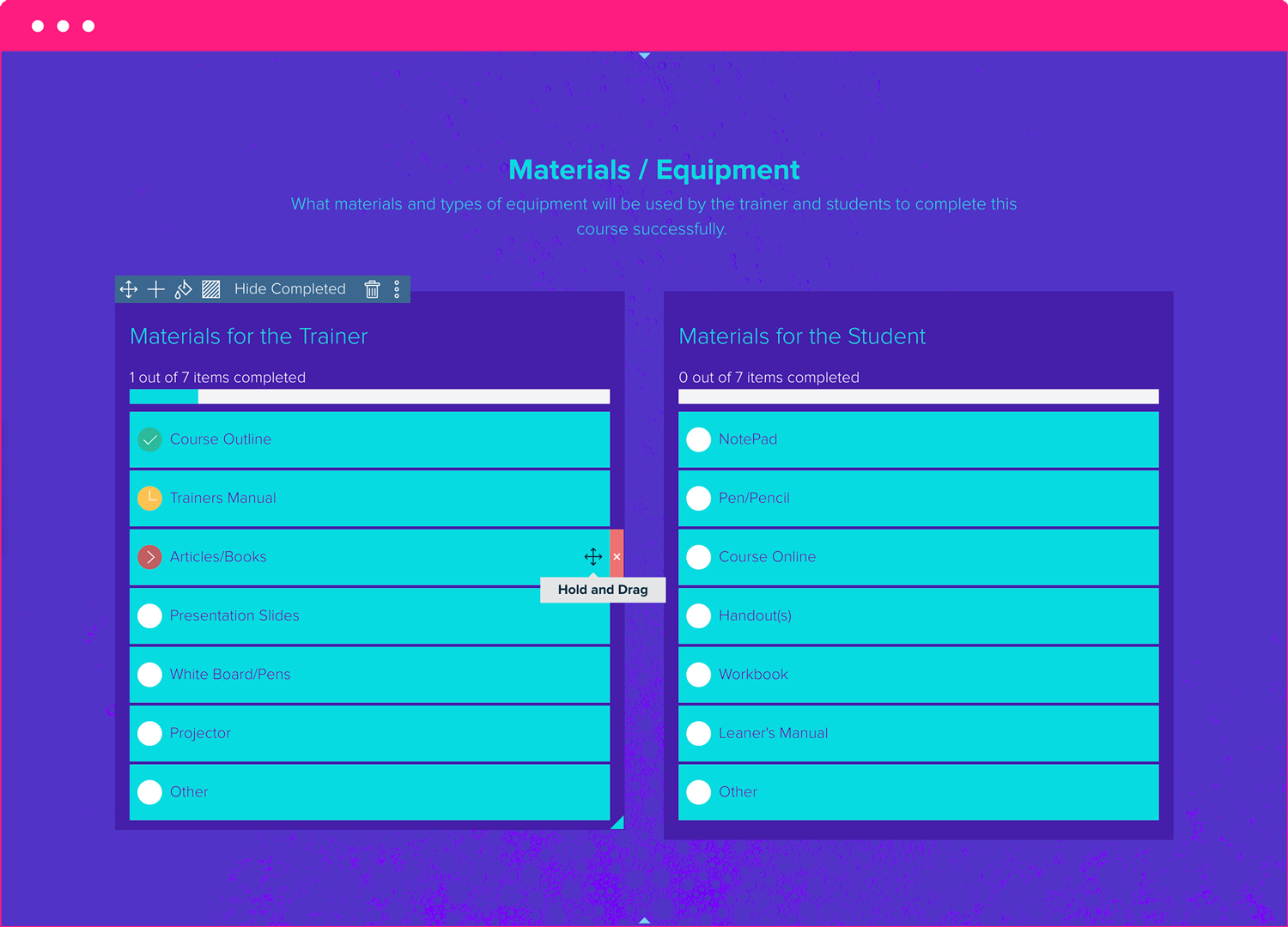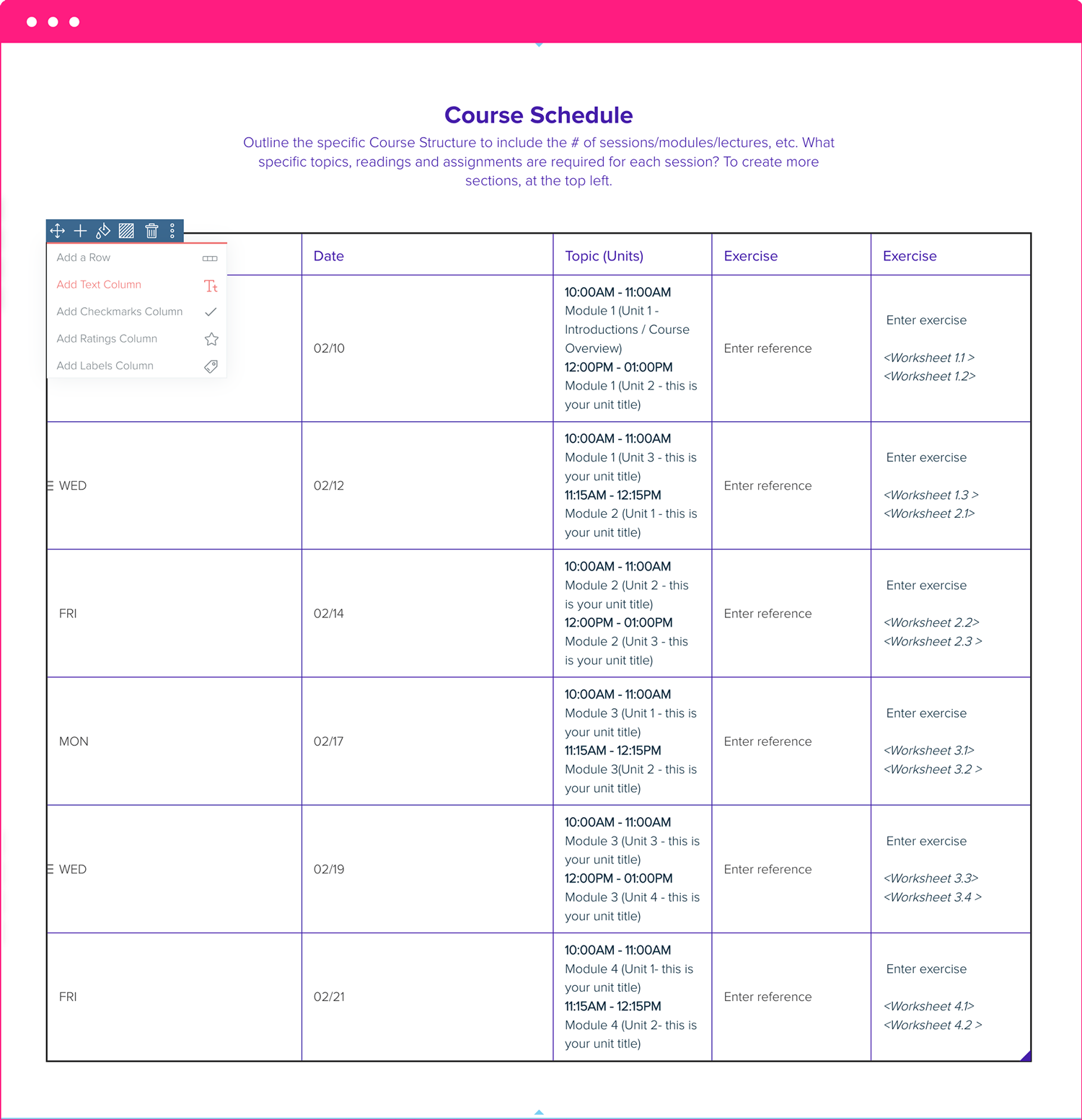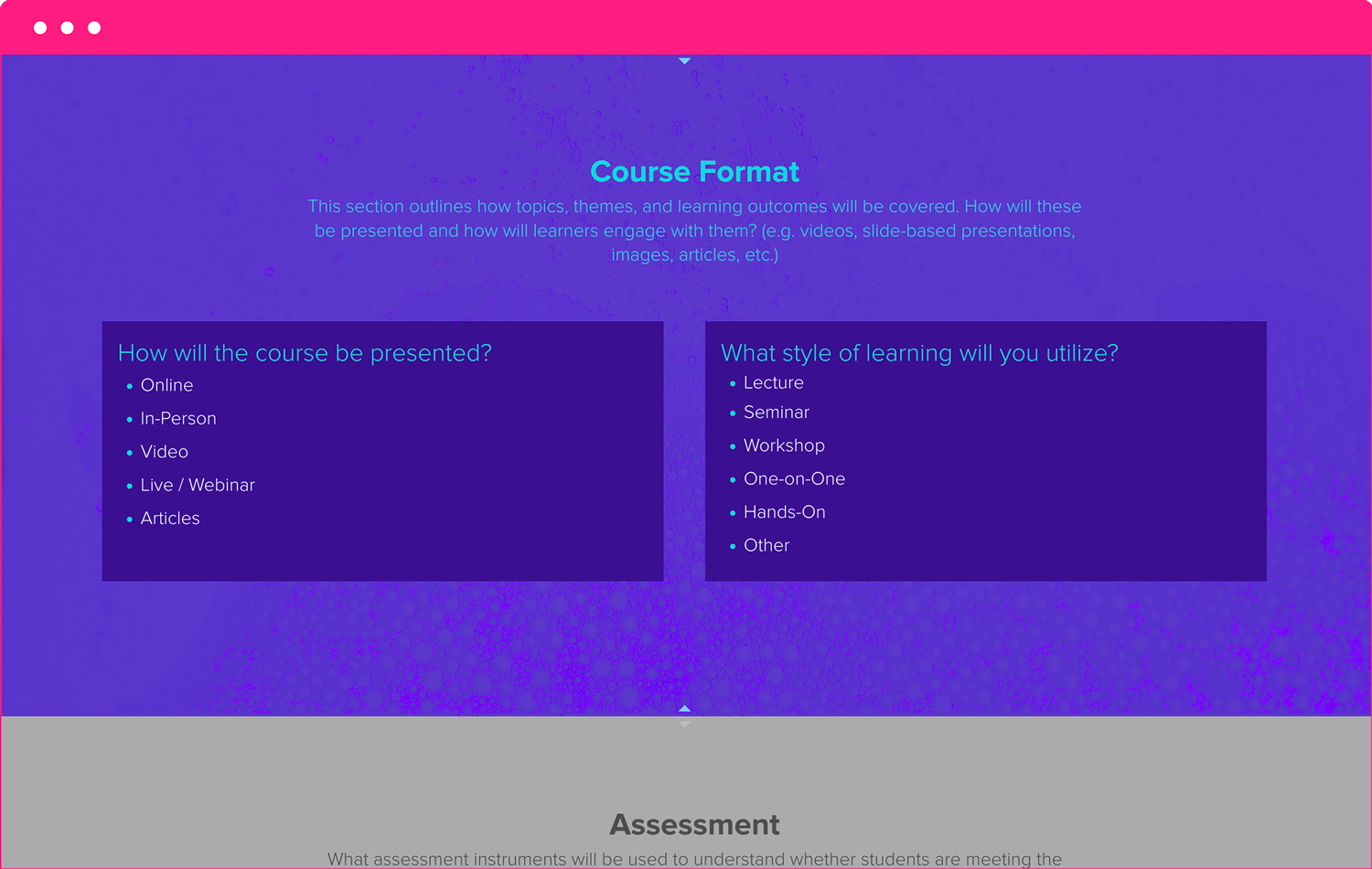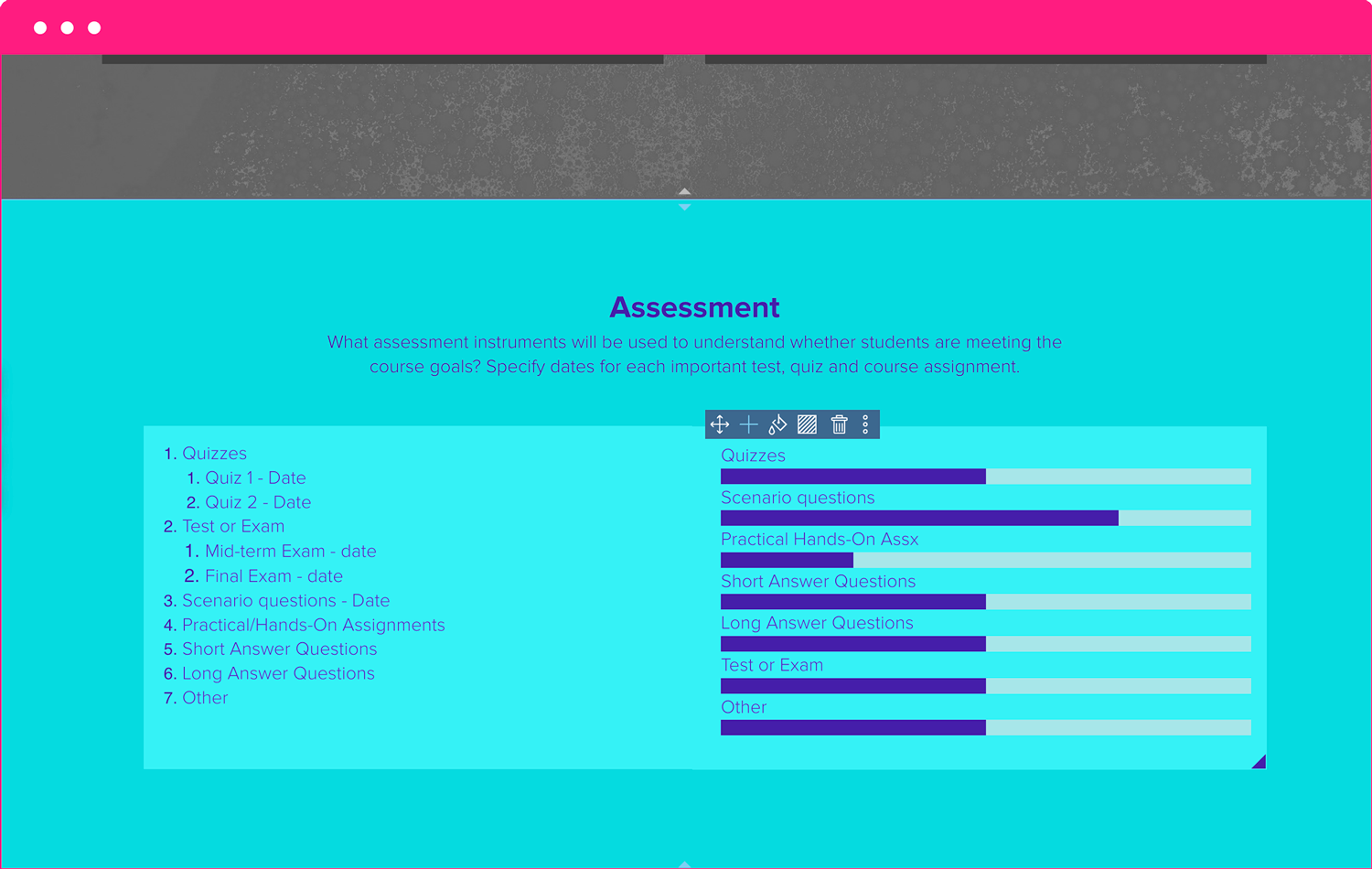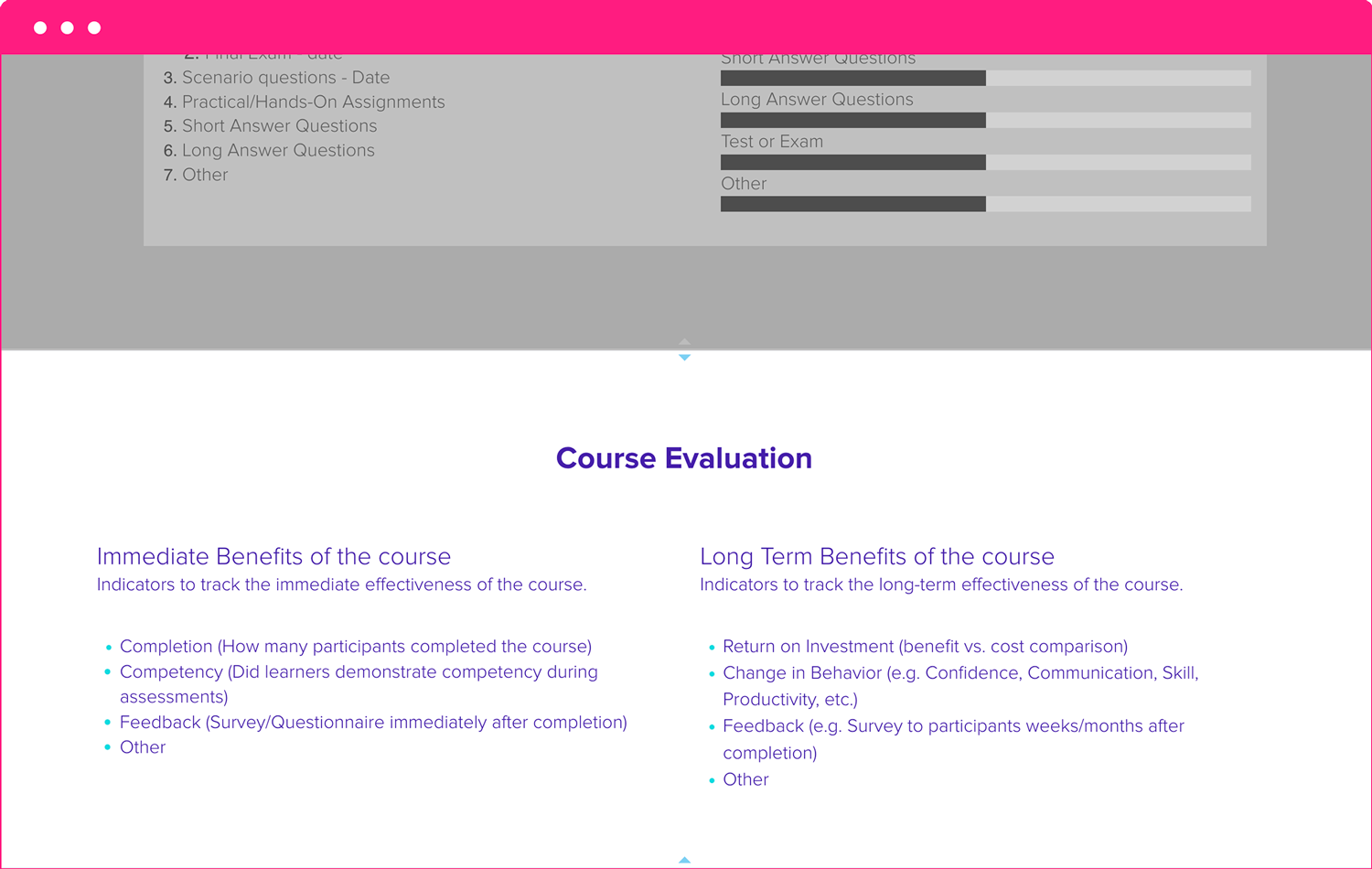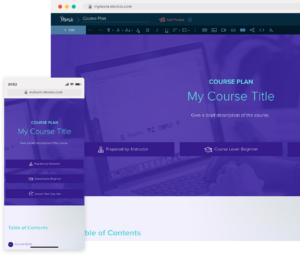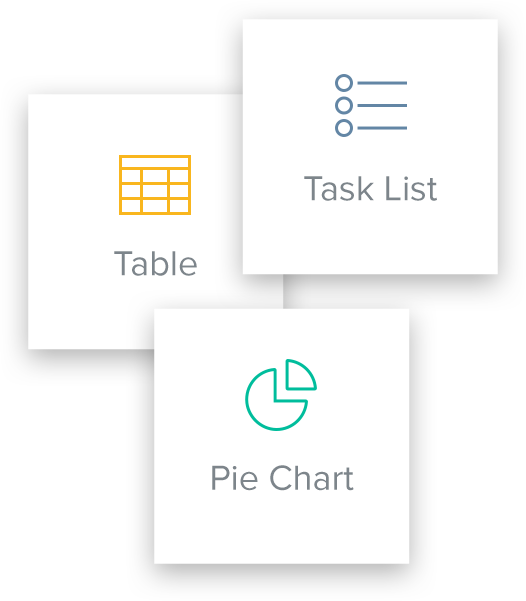How To Plan A Course Outline
Updated by Xtensio
A course plan is an essential part of designing any course and helps communicate the core values and goals of the course you’ll be teaching. The lesson plan is a detailed outline of course objectives, schedules, readings, assignments, and information about how the course will be taught and measured. Use this step-by-step guide to create and iterate on your course plan, easily.
Follow along and explore the course outline template.
Xtensio is your team space for beautiful living documents.
Create, manage and share business collateral, easily.
Table Of Contents
What is the purpose of a Course Outline?
Consider this: Your favorite band has just released a new album and, in a stroke of extraordinary luck, they decide to host a private concert in your city. Excited and thrilled, you book your ticket right away. The day arrives, the lights dim, and the music starts – but to your dismay, the band is all over the place. They jump from their latest songs to their oldest hits without any logical sequence. Some songs are cut off halfway through, and the band members constantly seem confused about what comes next. Instead of the mesmerizing experience you were expecting, the evening turns into a chaotic mess. You leave feeling disappointed, knowing the band could have given so much more if they’d planned their playlist – their outline – effectively.
This is how your learners may feel if you embark on creating a course without a proper outline. A course outline serves as a roadmap, ensuring a logical flow of information and a coherent learning experience. Without it, learners may end up as disappointed as the audience at the concert.
If you frequently find yourself in the position of creating lesson plans, or if you simply require some guidance for making a weekly lesson plan, this guide will help you explain everything about writing course outlines.
How to Write a Course Outline Step-by-Step Guide
The course plan helps educators and instructors plan and communicate the core values and goals of the course you’ll be teaching. It is a detailed outline of course objectives, schedule, readings, assignments and quizzes, how the course will be taught and measured. (this line is redundant) A detailed lesson outline will help you:
- Set course goals, develop student learning objectives, create and align assessment plans, and establish a schedule for your course.
- Guide student expectations by outlining goals, materials, timelines, and learning outcomes.
- Provide a reference for colleagues, administrators, and accreditation agencies.
With Xtensio, you can easily generate your create lesson plans tailored to your course objective and learning outcomes. Loop in colleagues and department heads to create an effective, ongoing course outline. You can work hand-in-hand with colleagues, group projects, on a live doc, leave feedback, demonstrate knowledge about the course, and share a link so students are updated on the lesson plan and objectives throughout the course.
Create your course plan header
Introduce your lesson plan with the course title and a brief description of the course. Add the instructor’s name, course level and date, time, and location. You can also update the folio color scheme and background to match your company branding.

QUICK TIP: Once you set up your header section, you can save a custom template to easily repurpose it for other lesson plans.
Consult colleagues and outline your course table of contents
Successful courses require careful planning and continual revision. Take time to really think about your course objectives before beginning to put together your weekly lesson plans.
Consult with colleagues who have taught the same or similar courses in order to learn from their tactics, student expectations, and outcomes. If you are team-teaching, you and your teaching partners should start planning ahead of time to consider course goals, teaching philosophies, course content, teaching methods, and course policies, as well as particular roles for each instructor.
When undertaking a team-teaching journey, you and your fellow instructors need to initiate the planning process well in advance. This proactive approach will allow your team to thoroughly evaluate the course objectives, align teaching philosophies, strategize the course content, determine effective teaching methodologies, and set forth clear course policies. Furthermore, defining distinct roles for each instructor will ensure a smooth and cohesive teaching experience.
The table of contents should include:
- Course Goals
- Course Learning Outcomes
- Materials/Equipment
- Course Schedule
- Course Format (Style)
- Assessment
- Course Evaluation
- Class time
Define course goals and learning outcomes
Course goals should be student-centered, not teaching-centered. One way to formulate these goals is to determine what students should be learning in terms of content, cognitive and personal development. Be specific and outline what you want your students to know or care about by the end of the course.
- Are students understanding what they should get from your course in 5-10 years?
- How does this course relate to other courses in the discipline? How would you define the course goals accordingly (e.g., for an introductory, fundamental, or advanced course in the discipline)?
Learning outcomes help break down the larger course and program goals into observable and measurable objectives. These outcomes should be learning-centered, not teaching-centered.
- How should taking your course change students?
- What skills is this course giving students?
Define materials and equipment students will need for your course
What tools and equipment will the educator and students utilize to effectively finish this course?
For example, materials for the teacher may include:
- Trainers Manual
- Articles/Books
- Presentation Slides
- White Board/Pens
- Projector
- Other
And materials the student may need could be:
- Note Pad
- Pen/Pencil
- Course Outline
- Handout(s)
- Workbook
- Leaner’s Manual
- Other
Plan your course schedule
Outline the specific Course Structure to include the number of sessions/modules/lectures, etc. What specific topics, readings, and assignments are required for each session?
When preparing an effective lesson plan, consult the relevant academic calendars, and keep in mind major religious holidays and significant campus events (for example, Winter Break, and Homecoming). And allow time for active learning to occur during classes and for students to complete major assignments and prepare for exams.
At a minimum, your course schedule should contain, the date and time of each session, topics and units (modules) of your course, required readings, assignments, and major exams.

QUICK TIP: To create more sections in the course schedule, duplicate the canvas to repurpose the content.
Outline your course format
Detail how topics, themes, and learning outcomes will be covered. How will these be presented and how will learners engage with them? (e.g. videos, slide-based presentations, images, articles, etc.) Select and develop teaching methods and tools that are 1) appropriate for the size of the class and 2) consistent with the course goals.
Course presentation could include:
- Online
- In Classroom
- Video
- Live Webinar
- Articles
You should also detail the learning style you’ll use in your course.
- Lecture
- Seminar
- Workshop
- One-on-One
- Workbook
- Hands-on
- Other
Explain how you will assess your course
What assessment instruments will be used to understand whether students are meeting the course goals? Specify dates for each important test, quiz, and course assignment.
Assessment may include quizzes, tests, exams, scenario questions, hands-on assignments, written papers, labs, etc.
Keep these things in mind when defining your course assessment:
- Do assignments reflect and help achieve course goals? For example, are the papers required for the course an appropriate genre and length? How much time will you give students to complete these papers?
- Do exams and quizzes reflect course goals? Do they measure the extent to which students are achieving the learning objectives you have set out for the course?
- Will the students have an opportunity to acquire and practice the skills that are required for exams and major assignments?
- Are there any practical tasks that should be assigned to help students practice the course?

QUICK TIP: Use charts and graphs to visualize assessment styles and course assignments.
Evaluate your course afterward and iterate for the next one
Course planning is a never-ending activity. Taking the time to review your one lesson once it is completed can assist you in planning and revising for the next lesson. Remember the importance of teaching core concepts and critical-thinking skills along with the content of your course.
Understand and detail indicators of immediate course benefits, including:
- Completion (How many participants completed the course)
- Competency (Did learners demonstrate competency during assessments)
- Feedback (Survey/Questionnaire immediately after completion)
Think about indicators of the long-term effectiveness of your course as well:
- Return on Investment (benefit vs. cost comparison)
- Change in Behavior (e.g. Confidence, Communication, Skill, Productivity, etc.)
- Feedback (e.g. Survey to participants weeks/months after completion)
Share your course plan as a link, monitor, evaluate & iterate
Your lesson should be centered around the course goals and student objectives. If effective, the course plan will help you develop student learning objectives, guide student expectations and provide a reference for future courses, colleagues, and administrators.
When you’ve finished creating your sample lesson plan with Xtensio’s editor, you can send the live link to your folio to share it as a responsive webpage (and add password protection), export a PDF and post it on your bulletin board and continuously optimize with new learnings. The course plan is adaptable just like other Xtensio tools, it can and should be repurposed, revisited, and revised regularly.
Understanding the Difference Between a Training Course Outline and a Simple Course Outline
A training course outline and a simple course outline share some basic elements, such as listing course objectives, assignments, materials needed, and a class schedule. However, they also differ significantly in terms of their goals, the level of detail involved, and the type of learning experience they facilitate.
Training Course Outline
A training course outline is typically used for professional training programs, vocational training, or workplace training. These courses are often highly practical and focus on specific skills needed for a particular job or industry. However, these courses can be used professionally to help in the skill development of both the student (smart and average).
Key Differences
- Practical Focus: Training course outlines tend to focus on practical skills, competencies, and applications. They are designed to guide students to master a specific set of skills or processes.
- Detail Level: Training course outlines generally include more specific details about the instructional methods to be used, the practical exercises that will be included, and the competency levels students are expected to reach.
- Assessment: In training courses, the assessments are typically performance-based, focusing on learners’ ability to demonstrate their new skills. The assessments might involve simulations, role-plays, or on-the-job demonstrations.
- Training Resources: Training course outlines often detail specific training resources, such as simulations, hands-on equipment, or job aids.
Simple Course Outline
A simple course outline, often used in academic settings like high schools and colleges, provides a general overview of a course’s content, goals, and methods of assessment.
- Theoretical Focus: Simple course outlines tend to focus more on knowledge acquisition and understanding theoretical concepts. They are usually geared towards an overview of a subject area or discipline.
- Detail Level: While they can be quite comprehensive, simple course outlines might not go into as much detail about specific teaching methods or learning resources. They provide an overview of the topics to be covered, suggested readings, assignments, and a class schedule.
- Assessment: The assessments in simple course outlines typically involve written assignments, tests, or exams. These assess students’ understanding of course materials and their ability to think critically about the topics covered.
- Academic Resources: Simple course outlines often list textbooks or academic articles as course materials, with less emphasis on hands-on or practical resources.
In summary, while there is some overlap between training course outlines and simple course outlines, they serve different purposes. Training course outlines focus more on skill acquisition for specific jobs or industries, while simple course outlines aim to provide a broader understanding of a particular subject or academic discipline. Both are crucial tools in their respective settings, guiding learners through their courses and helping educators structure their teaching.
Frequently Asked Questions
What is a course outline?
A course outline is a roadmap for a class, detailing its core values, goals, schedules, assignments, and how it will be taught and assessed. It’s vital for ensuring a logical flow of information and a coherent learning experience.
What are the key components of a course outline?
A comprehensive course outline includes the following:
– Course goals
– Learning outcomes
– Materials/Equipment
– Course Schedule
– Course format or style
– Assessment methods
– Course evaluation
How can I introduce my course plan?
You can start your course plan by introducing it with the course title, a brief description, the instructor’s name, course level, and details about time and location.
How can I define course goals and learning outcomes?
Course goals should be student-centered and specific to what students should learn in terms of content, cognitive and personal development. Learning outcomes help break down the larger course and program goals into observable and measurable objectives.
How to plan a course schedule?
The course schedule should contain the date and time of each session, topics and units (modules) of your course, required readings, assignments, and major exams. It should consider major religious holidays and significant campus events.
What is Xtensio’s role in course planning?
Xtensio offers an easy-to-use platform where you can generate lesson plans tailored to your course objectives and learning outcomes. You can collaborate with colleagues and share the lesson plan with students, ensuring everyone is updated on the course progress and objectives.
